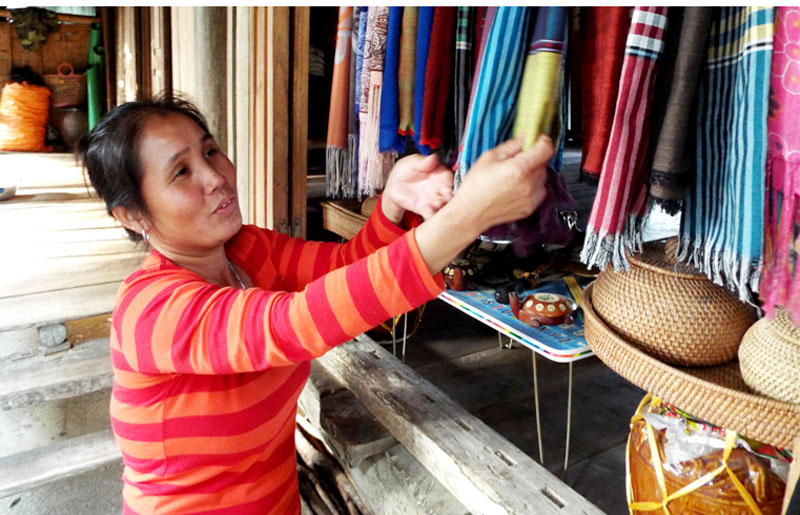
HBO – Giang Mo village in Binh Thanh commune (Cao Phong district) has been become an outstanding Muong cultural highlight for years. Separating from smoke and noise of urban areas, the picturesque romantic vista of Giang Mo is an ideal destination for those who want to find tranquility. Furthermore, this is one of the ethnic-inhabitedvillages which is defined by the provincial tourism sector to become a spearhead product to attract visitors when talking about Hoa Binh.

Brocade products made by
Giang
Molocals are displayed to sell for tourists
Peaceful
Giang
Mo village
is located in the foot of Mo Mountain, about 12km from Hoa Binh city’s downtown.
It is not difficult to reach the village. The village is home to 145 households
who all belong to the Muong ethnic group. It is considered an alive
museum of
Muong ethnics’ traditional culture as
there remains the traditional architecture of stilt houses, looms of Muong
ethnics, and work tools such as rice mortars, bows, cross-bows, and tools for
mountain field works.
Visiting Giang Mo today,
tourists can walk on the small path running throughout the village, contemplate
the untouched beauty of the nature, and can stop at any stilt house to learn
about Muong culture, enjoy bamboo pole dances beside jars of ruou can (a kind
of wine drunk out of a jar through pipes), and experience daily work of locals
such as caring for poultry and cattle, doing field work, hunting for animals
and picking fruits.
Visitors are also offered a
chance to listen to Muong young women’s stories about weaving and traditional brocade
products such as clothes, bags and scarves and enjoy Muong people’s dishes such
as steamed sticky rice, pork, hill vegetables and spring fish.
At this time, visitors can
also enjoy fresh air and smell the fragrance of rice which is being harvested.
Tran Quang Minh, a second-year student of the
Universityof
Culture said: "My classmates
decided to choose
Giang
Mo to visit. This tour helps us understand
more about the life and daily activities of Muong ethnics and have interesting
first-ever experience such as weaving brocade, throwing "con” (a
cloth ball) through a ring or shooting with a crossbow with local children. We
have noteworthy memories in this beautiful village”.
Village head Nguyen Van
Hau said: "
Giang
Mo village
welcomes thousands of visitors, from inside and outside the country each year.
We are trying to increase the quality of services to make tourists comfortable.
We pay attention to keeping everything clean, from houses, alleys to bedding.
Specially, the village controls locals’ insistence on buying goods”.
All these things create typical
features of
Giang
Mo village. Therefore, although
Giang
Mois not an impressive ecological tourist site with specular natural landscapes
or a services tourist attraction with professional products, it gently attracts
visitors with its plain beauty and the heartiness of local residents./.
Spanning thousands of hectares and winding gracefully along mountain slopes, hillsides, and riverbanks, the terraced rice fields of Lac Son District present a stunning and captivating beauty. This region, renowned for its remarkable terraced landscapes, is also the centre of Hoa Binh Culture known for numerous archaeological sites.
The life of Mong people in Hang Kia and Pa Co communes of Mai Chau district has improved much thanks to tourism development.
The man-made Hoa Binh Lake, with a water surface area of approximately 9,000 hectares and a capacity of 9.45 billion cubic meters, stretches over 200 kilometers from Hoa Binh to Son La provinces. With the goal of developing into a national tourism area, the Hoa Binh Lake tourism area is expected to not only become the largest tourism centre in the province but also one of the 12 key tourist destinations in the northern midland and mountainous region of Vietnam.
Da Bia hamlet, now Duc Phong, in Tien Phong commune, Da Bac district, was once almost isolated from the outside as the only way to the hamlet was to get a boat ride across the Hoa Binh reservoir. However, as its tourism potential has been unleashed, the hamlet has established itself as one of the most attractive destinations on the tourism map. It has even received the ASEAN Community-Based Tourism Awards in 2019.
In the first 9 months of 2024, Mai Chau district, Hoa Binh province welcomed over 684 thousand visitors to visit and relax. In which, over 516 thousand domestic visitors and more than 168 thousand international visitors. Total revenue from tourism is estimated at over 821 billion VND.
Da Bac district, bestowed with stunning landscapes, is developing ecological and resort tourism offerings. Several tourist sites, put into operation this year, has attracted throngs of high-spending and young domestic visitors.



